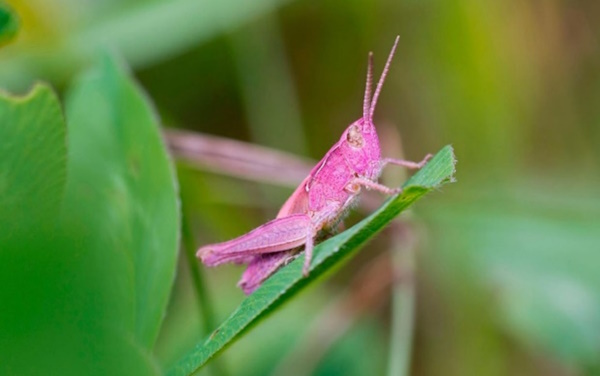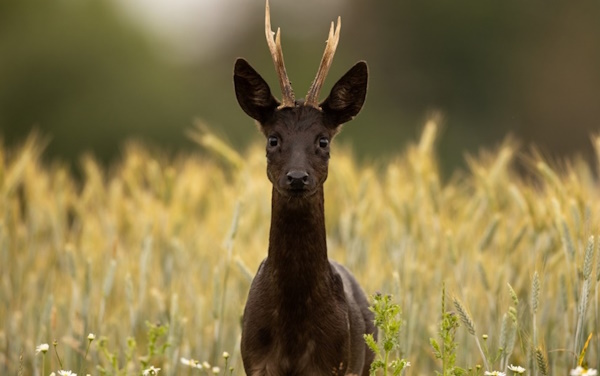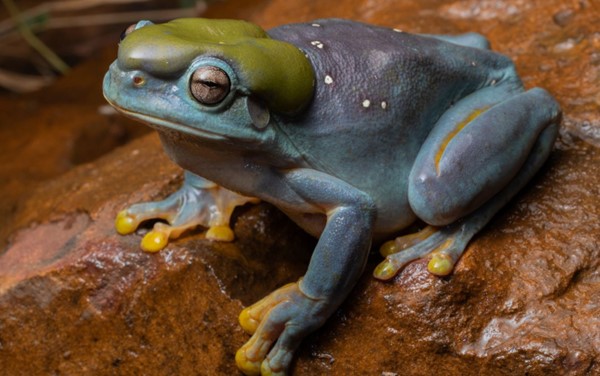Colors in Nature

Table of Contents
1. Pretty in Pink

© Christopher Smith / Alamy / Alamy Stock Photos / mauritius images
Are you familiar with erythrism? The genetic defect ensures that too few black pigments and too many red pigments are formed, which then leads to reddish hair, skin or feather coloration. This can result in something as eye-catching as a pink grasshopper, for example. However, this extraordinary coloration is not good luck for the grasshoppers. Unfortunately, they are much easier for predators such as birds to see, which is why they hardly stay alive long enough to reproduce. [1], [2]
Another representative of the animal kingdom with erythrism is Inspector Clouseau, a ray named after the detective in "The Pink Panther". It was first spotted in the Great Barrier Reef in 2015 and is the only known pink manta ray in the world. [3]
Not as rare as a pink grasshopper, but just as unique: the spectro2guide not only measures color and gloss, but also fluorescence. And when fluorescence is detected? The pink status LED flashes! Click here and learn more.
2. Black is Beautiful

© Liddy Lange / https://naturfotografen-forum.de/
Brown-reddish and shy. This is how roe deer are known in the wild. However, it is only in north-western Germany that there are roe deer that are out of the ordinary in terms of color. This is caused by so-called melanism: a dark to black coloration of otherwise differently colored animals caused by the storage of melanins. [4] Melanism can be inherited or caused by increased sun exposure, higher humidity, lower temperature and other factors. In the animal world, melanism occurs not only in roe deer, but also in many other species. The best-known melanistic animal in the world is the black panther, a leopard (Panthera pardus) or jaguar (Panthera onca), whose fur is black throughout. It is not known exactly how many of these beautiful black roe deer there are in Germany. [5]
Did you know that the spectro2guide Pro was specially developed to measure the deepest black with the highest accuracy? Click here and get to know the specialist for measuring Jetness.
3. A Frog out of the Ordinary

© Jake Barker / Australian Wildlife Conservancy (Detail)
Yellow plus blue is green. Every child knows color mixing law. But what if a normally green animal is incapable of producing yellow pigments?
In Australia's Charnley River-Artesian Range Wildlife Sanctuary, the usually light green-colored Australian Tree Frog has been spotted in blue. [6] It apparently has a rare mutation called axanthism, which suppresses the development of yellow color pigments - leaving only the blue. Among thousands of frogs, this may only occur once; the Australian Tree Frog is the first known case of its kind. [7] The moor frog is not nearly as rare, but it is still very special. At the height of the mating season, the skin of males can turn bluish-purple to intense sky-blue - either only on some parts of the body or on the entire upper side including the extremities. [8]
To our knowledge, the spectro2guide has not been used to measure the skin of frogs, so far. Yet we offer various accessories to measure wet drawdowns and pressed powder without contact.
4. B for Bear? B for Brown!

© Weibo / CCTV
The panda, with its distinctive black and white coat, is adored by the world and considered a national treasure in China. As the heraldic animal of the WWF, they are also the symbol for endangered animals. But even these exceptional animals seem almost ordinary when you consider that there are also a vanishingly small number with brown fur coloration. Only seven brown-and-white pandas have ever been documented — all from Qinling, a mountain range in the Chinese province of Shaanxi. There is currently only one brown panda living in captivity, called Qizai. The brown pandas are missing a short sequence of DNA in Bace2, a pigmentation-related gene, according to a study published by the "Proceedings of the National Academy of Sciences". [9], [10]
Unfortunately, we cannot yet capture the color of very last tip of the hair. However, the new spectro2go XS with reduced measuring aperture can support you in the quality control of small samples. Click here to find out more about the newest member of the spectro2Family.
5. Literature
- https://www.bbc.com/news/articles/czknv1233dko
- https://www.geo.de/natur/tierwelt/grossbritannien--pinkfarbener-grashuepfer-verzaubert-naturfreunde-33622510.html
- https://www.nationalgeographic.de/tiere/2020/02/der-rosarote-manta-wie-kam-diese-einzigartige-faerbung-zustande
- https://www.spektrum.de/lexikon/biologie/melanismus/41902
- https://www.prosieben.de/serien/newstime/news/in-deutschland-einzigartig-schwarze-rehe-beschaeftigen-wildtierexperten-332129
- https://www.spektrum.de/alias/bilder-der-woche/amphibien-mutierter-frosch-begeistert-biologen/2223988
- https://edition.cnn.com/2024/07/11/science/tree-frog-blue-mutation-scli-intl-scn/index.html
- https://de.wikipedia.org/wiki/Moorfrosch
- https://www.scientificamerican.com/article/rare-brown-panda-mystery-solved-after-40-years/
- https://www.faz.net/aktuell/wissen/leben-gene/grosse-pandas-eine-mutation-macht-aus-schwarzen-flecken-braune-19562876.html